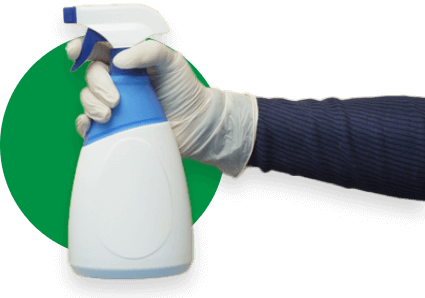Sterilization vs disinfection represents different microbial control levels for business facilities. Sterilization eliminates all microorganisms, including bacterial spores. Disinfection kills most pathogens but not necessarily spores. Businesses choose between sterilization vs disinfection based on infection risk and surface criticality.
What Are Sterilization vs Disinfection?
Sterilization vs disinfection define two distinct approaches to microbial control. Sterilization destroys or removes all forms of microbial life, including bacteria, viruses, fungi, and bacterial spores. This process renders items completely sterile with zero living microorganisms. Disinfection eliminates or inactivates most pathogenic microorganisms on surfaces and objects. However, disinfection does not necessarily kill bacterial spores. Professional disinfecting services help businesses implement appropriate protocols.
Why Sterilization vs Disinfection Matters
Understanding sterilization vs disinfection prevents costly mistakes and health risks. Using unnecessary sterilization wastes money on expensive processes. Choosing inadequate disinfection leaves dangerous pathogens that threaten occupant health. Regulatory agencies mandate specific protocols based on facility type and infection risk. Medical facilities face strict requirements, while offices need routine disinfection. Proper selection between sterilization vs disinfection protects employees, satisfies compliance requirements, and optimizes cleaning budgets.
Key Differences Between Sterilization vs Disinfection
The distinction between sterilization vs disinfection centers on completeness and application. Understanding these differences helps businesses make informed decisions:
- Microbial Elimination Level: Sterilization achieves complete microbial destruction, including resistant bacterial spores, while disinfection eliminates most pathogens but not all spores.
- Process Intensity: Sterilization requires extreme conditions like high heat, powerful chemicals, or radiatio,n while disinfection uses EPA-registered antimicrobial products with specified contact times.
- Application Areas: Sterilization applies to surgical instruments, laboratory equipment, and items penetrating tissues, while disinfection targets environmental surfaces and non-critical equipment.
- Regulatory Requirements: Sterilization protocols follow strict medical standards with validation requirements, while disinfection follows EPA guidelines and industry best practices.
- Cost Considerations: Sterilization requires expensive equipment and extended processing time, while disinfection offers cost-effective solutions for routine facility maintenance.
These distinctions clarify when businesses need comprehensive high-level disinfection versus standard disinfection protocols.
Sterilization vs Disinfection Process Comparison
Sterilization vs disinfection processes differ significantly in methods and outcomes:
| Factor | Sterilization | Disinfection |
| Microbial kill level | 100% including spores | 99.9% of pathogens, not all spores |
| Primary methods | Heat, chemicals, radiation, filtration | EPA-registered disinfectants |
| Typical duration | 15-60+ minutes depending on method | 30 seconds to 10 minutes contact time |
| Equipment requirements | Autoclaves, specialized chambers | Spray bottles, foggers, wipes |
| Validation requirements | Biological indicators, strict monitoring | Product label compliance, documentation |
| Cost per application | High (equipment, energy, time) | Low to moderate (product costs) |
This comparison demonstrates why businesses reserve sterilization for critical applications and rely on disinfection for routine facility maintenance.
Variation by Facility Type
Sterilization vs disinfection requirements vary dramatically across facility types:
- Medical and Dental Clinics: Must sterilize surgical instruments, dental tools, and items contacting internal tissues using autoclaves while disinfecting exam tables, waiting areas, and environmental surfaces with hospital-grade products.
- Offices and Commercial Buildings: Rely exclusively on routine disinfection for desks, conference rooms, kitchens, and restrooms with EPA-registered disinfectants applied to high-touch surfaces daily or weekly.
- Laboratories and Research Facilities: Require sterilization for culture media, glassware, and experimental equipment to prevent contamination while disinfecting benches, floors, and shared equipment.
- Industrial and Warehouse Settings: Use disinfection protocols for break rooms, restroom facilities, and equipment controls with industrial-strength products accommodating heavy-use environments.
When Businesses Need Sterilization
Sterilization becomes non-negotiable when infection risk is highest. Most general businesses never require sterilization, but specific applications demand this absolute level:
- Surgical and Invasive Procedures: Medical facilities must sterilize scalpels, forceps, and any instruments penetrating skin or contacting internal tissues to prevent bloodborne pathogen transmission.
- Laboratory Contamination Prevention: Research facilities sterilize glassware, culture media, and experimental equipment to ensure accurate results without microbial interference.
- Pharmaceutical Manufacturing: Sterile medication production requires rigorous sterilization of production equipment, containers, and environments to ensure product safety and regulatory compliance.
- Tattoo and Piercing Applications: Artists must sterilize needles and instruments, breaking skin barriers to prevent hepatitis, HIV, and other bloodborne disease transmission.
Understanding how heat and alcohol sterilize medical equipment clarifies why these methods are essential for high-risk applications.
Sterilization Methods for Critical Applications
Four primary sterilization methods address different equipment and material requirements. Each method achieves complete microbial elimination through distinct mechanisms:
- Heat Sterilization: Uses moist heat autoclaves at 121°C with high-pressure steam for surgical instruments and glassware, or dry heat ovens at 160-170°C for moisture-sensitive materials like powders and oils.
- Chemical Sterilization: Utilizes ethylene oxide gas, hydrogen peroxide plasma, or ozone for heat-sensitive items, such as plastics, electronics, and complex medical devices that would be damaged by autoclaves.
- Radiation Sterilization: Applies gamma rays for industrial-scale sterilization of packaged medical supplies like syringes and gloves, or UV-C light for surface and air sterilization in controlled environments.
- Filtration Sterilization: Removes microorganisms physically using 0.22-micrometer filters for heat-sensitive pharmaceuticals, IV solutions, and cell culture media without chemical exposure.
These specialized processes require expensive equipment and trained personnel, explaining why businesses limit sterilization to truly critical applications.
When Businesses Need Disinfection
Most Fort Worth businesses rely on routine disinfection rather than sterilization. Disinfection addresses everyday infection risks without the complexity and cost. Businesses prioritize disinfection for high-touch surfaces throughout facilities:
- Office Environments: Disinfect doorknobs, light switches, desks, keyboards, phones, conference tables, break room appliances, and elevator buttons with EPA-registered products applied daily or weekly.
- Reception and Public Areas: Clean counters, waiting room furniture, and shared equipment where multiple people contact surfaces throughout business hours, requiring frequent disinfection cycles.
- Restroom Facilities: Apply antimicrobial products to fixtures, door handles, countertops, and high-contact areas multiple times daily in high-traffic facilities serving many occupants.
- Food Service Areas: Use food-safe disinfectants on countertops, tables, appliances, and food-contact surfaces following strict protocols preventing foodborne illness transmission.
Professional office disinfecting practices ensure these surfaces remain safe without unnecessary sterilization protocols.

Disinfection Products and Application Methods
Effective disinfection requires proper product selection and application techniques. Professional services ensure optimal results:
- EPA-Registered Disinfectants: Use List N products proven effective against target pathogens with documented kill times and safety profiles for commercial environments.
- Pre-Cleaning Protocols: Remove visible dirt and debris before disinfectant application since organic matter shields pathogens from chemical action, reducing effectiveness.
- Contact Time Compliance: Maintain wet surface contact for labeled duration ranging from 30 seconds to 10 minutes, depending on product formulation and target organisms.
- Application Methods: Choose appropriate delivery systems, including spray bottles for targeted areas, electrostatic foggers for comprehensive coverage, or pre-saturated wipes for convenience.
Understanding the difference between cleaning and disinfecting ensures businesses follow proper two-step protocols for maximum pathogen elimination.
High-Level vs Low-Level Disinfection Options
Within disinfection protocols, businesses choose between high-level and low-level approaches. This distinction helps optimize cleaning budgets while maintaining safety:
- High-Level Disinfection: Destroys all microorganisms except bacterial spores, used for semi-critical medical equipment contacting mucous membranes, requiring products like glutaraldehyde or orthophthalaldehyde.
- Intermediate-Level Disinfection: Inactivates most bacteria, fungi, and viruses but not necessarily bacterial spores, appropriate for surfaces with blood or body fluid contamination.
- Low-Level Disinfection: Kills most bacteria and some viruses and fungi within short contact times, sufficient for routine environmental surface disinfection in non-medical settings.
Learn more about high-level vs low-level disinfectant selection for specific facility needs and risk levels.
Building an Effective Sterilization vs Disinfection Strategy
Smart facilities avoid one-size-fits-all approaches by strategically applying sterilization vs disinfection based on risk assessment:
- Risk Assessment: Evaluate industry requirements, occupant vulnerability, daily traffic patterns, and high-contact surfaces, determining appropriate protocols for different facility zones.
- Protocol Documentation: Establish clear guidelines specifying when to use sterilization for critical items versus routine disinfection for environmental surfaces, ensuring consistent execution.
- Staff Training: Educate employees on proper product selection, application techniques, contact time requirements, and safety precautions, preventing protocol failures and chemical exposures.
- Monitoring Systems: Implement verification procedure, including biological indicators for sterilization and surface sampling for disinfection, confirming protocol effectiveness.
Facilities combining medical and office functions require hybrid strategies. For example, dental clinic disinfection protocols sterilize clinical instruments while disinfecting reception areas and administrative spaces.
Professional Service Benefits for Fort Worth Facilities
Professional cleaning partners eliminate guesswork from sterilization vs disinfection decisions. Expert services provide critical advantages:
- Customized Protocols: Develop facility-specific plans matching industry requirements, traffic patterns, and budget constraints, ensuring optimal pathogen control without unnecessary expenses.
- Product Expertise: Select appropriate EPA-approved disinfectants with correct contact times and safety profiles while maintaining proper chemical inventory and disposal procedures.
- Quality Assurance: Implement trained staff, professional-grade equipment, and verification systems, ensuring consistent protocol execution and documented compliance with regulatory requirements.
Comprehensive medical office cleaning protocols demonstrate how professional services integrate sterilization and disinfection appropriately.
Get Expert Sterilization vs Disinfection Guidance from Dallas Janitorial Services
Understanding sterilization vs disinfection protects your employees and optimizes cleaning investments. Strategic protocol selection prevents costly over-treatment and dangerous under-treatment. Dallas Janitorial Services brings decades of experience helping Fort Worth facilities implement appropriate cleaning protocols. Contact us today for a customized assessment and service plan.
Frequently Asked Questions About Sterilization vs Disinfection
How is sterilization different from disinfection?
Sterilization eliminates all microbial life, including bacterial spores, while disinfection kills most harmful bacteria and viruses but not necessarily spores. The core distinction between sterilization vs disinfection is this absolute elimination level versus pathogen reduction.
Do you sterilize or disinfect first?
Always clean items thoroughly before sterilizing or disinfecting. Removing visible dirt, soil, and organic matter is critical since debris shields microorganisms from chemical or physical processes, rendering sterilization vs disinfection ineffective.
What are the four types of sterilization?
The four primary sterilization methods are heat-based processes using autoclaves or dry heat ovens, chemical sterilization using ethylene oxide or hydrogen peroxide gas, radiation using gamma rays or UV-C light, and filtration for liquids and air.
What type of items should be disinfected rather than sterilized?
Non-critical items contacting only intact skin require disinfection not sterilization. This includes environmental surfaces like floors, walls, countertops, and desks, plus equipment like stethoscopes and blood pressure cuffs that never penetrate skin barriers.
When does a business need sterilization instead of disinfection?
Businesses need sterilization for instruments penetrating skin or contacting internal tissues, items used in invasive procedures, laboratory equipment requiring contamination-free conditions, and pharmaceutical manufacturing environments producing sterile products.
How long does sterilization take compared to disinfection?
Sterilization requires 15-60+ minutes, depending on method and load size, while disinfection needs 30 seconds to 10 minutes contact time. Sterilization’s longer duration reflects the complete elimination required versus disinfection’s pathogen reduction goal.







